The 9.7" iPad Pro Review
by Brandon Chester on June 1, 2016 9:00 AM ESTSystem Performance
Like the larger iPad Pro, the 9.7" iPad Pro uses Apple's A9X SoC. Apple is never very forthcoming with details like the clock speed for the CPU, GPU, and amount of DRAM. What we can determine about the SoC is that Apple has maintained the 2.2GHz maximum clock speed from the larger iPad Pro, while reducing clocks on the GPU and dropping to 2GB of LPDDR4 RAM.
The RAM situation on the 9.7" iPad Pro is somewhat surprising for a few different reasons. In their always-excellent teardown, the iFixit crew discovered that the smaller iPad Pro only had one Samsung 2GB LPDDR4 memory chip. This explains how Apple scaled down from 4GB to 2GB - the larger iPad Pro had two chips - but it also means that Apple has changed the amount of memory bandwidth available to the A9X SoC as well.
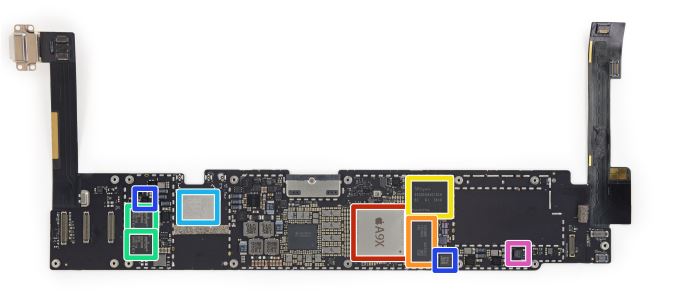
9.7" iPad Pro Logic Board (Image Courtesy iFixit)
To date, all Apple X-series SoCs have shipped with a larger 128-bit memory bus, and until now, Apple always fully populated that bus. So the 9.7" iPad Pro is an outlier in that regard, as this is the first time we've seen an X-series SoC with only the first 64-bit half wired up to a single memory chip in this fashion. In that respect it's a surprising decision from Apple, in part because of the importance of memory bandwidth in feeding the large, powerful GPUs on the X-series SoCs.
Consequently there is going to be more to the 9.7" iPad Pro than just the original Pro in a smaller chassis. The 9.7" iPad Pro should match the larger model in anything that depends heavily on CPU speed or memory bandwidth, while falling behind to some degree in GPU-bound tests. The 12 cluster PowerVR Series7XT GPU inside A9X will be having to make do with less memory bandwidth, though offset to some degree by the lower resolution of the screen.
With the above in mind, I quickly benchmarked the 9.7" iPad Pro on a couple of our memory bandwidth benchmarks. The results are somewhat inconclusive.
| Geekbench 3 Memory Bandwidth Comparison (1 thread) | ||||||
| Stream Copy | Stream Scale | Stream Add | Stream Triad | |||
| 9.7" iPad Pro | 17.1 GB/s | 11.5 GB/s | 12.9 GB/s | 12.8 GB/s | ||
| 12.9" iPad Pro | 20.8 GB/s | 15.0 GB/s | 15.3 GB/s | 15.1 GB/s | ||
I say "inconclusive" because although the 9.7" iPad Pro consistenly scores lower in Geekbench 3's memory bandwidth benchmarks and other memory benchmarks, it's never a 50% drop as we get on paper. In practice these numbers are far from the maximum memory bandwidth A9X is capable of, and I suspect that the CPU paths simply aren't wired in such a fashion that they can fully saturate A9X, especially given the fact that it's the GPU that needs the bandwidth more. So although we see some impact of the narrower memory bus in dedicated memory bandwidth benchmarks, these can't paint a very clear picture. It's going to be our high level GPU performance benchmarks that really give us an idea of the impact of reduced memory bandwidth.
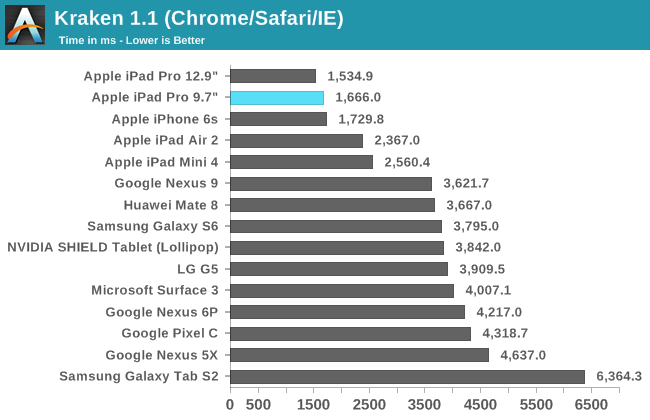
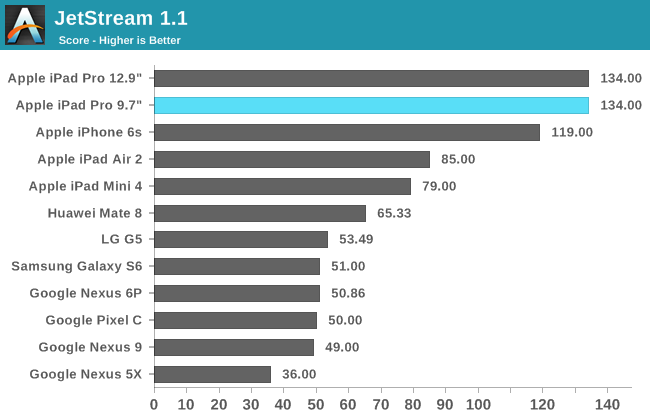
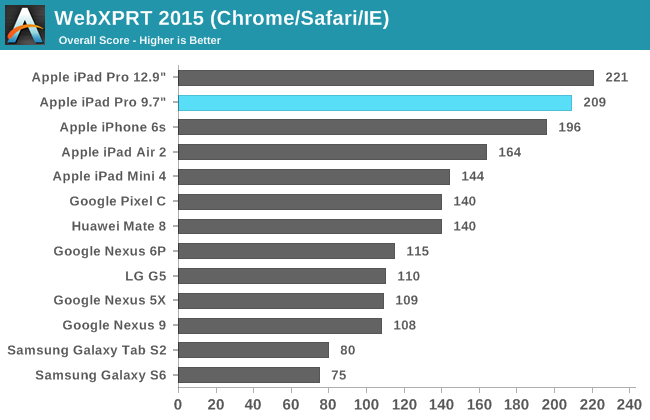
With the 9.7" iPad Pro having the same two 2.2GHz Apple Twister cores as the 12.9" model, it's no surprise to see the two neck and neck in our browser tests. In Jetstream 1.1 the two achieve the exact same score, while in the other two tests the 9.7" model is a bit slower, but with the gap being small enough to attribute to testing variance. With A9X Apple moved back to a dual-core CPU from A8X's tri-core CPU, with the move to TSMC's 16nm FinFET process allowing peak clock speeds to go up by 700MHz. Because JavaScript performance is mostly bound by a device's single threaded performance, A9X came with a significant performance uplift during web browsing. Given that the 12.9" iPad Pro offered the best web browsing performance of a mobile device, bringing that performance to the 9.7" iPad makes for a notable improvement over the performance of the iPad Air 2.
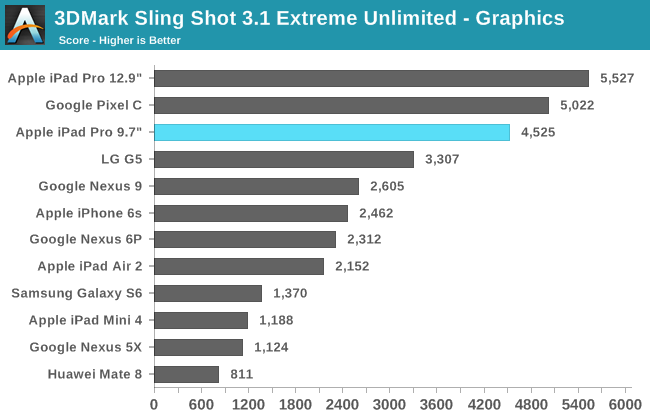
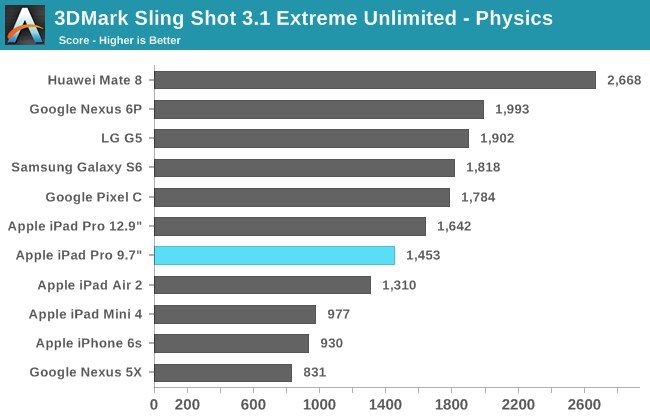

The 9.7" iPad Pro does well in 3DMark's graphics test, but like Ice Storm it doesn't do well in the physics test. It seems that this test is programmed in a similar way to Ice Storm, and in that sense I'm not sure how representative the physics test is of real-world performance because with an actual mobile game you wouldn't use highly random memory access and data structures with heavy memory dependencies when it would perform very poorly on your target devices. In any case, you can see that the 9.7" iPad Pro places third overall, with the 12.9" model at the top of the chart and the Pixel C coming right behind it.
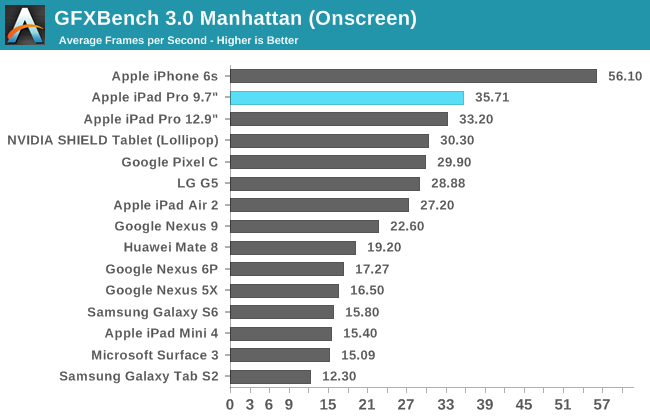
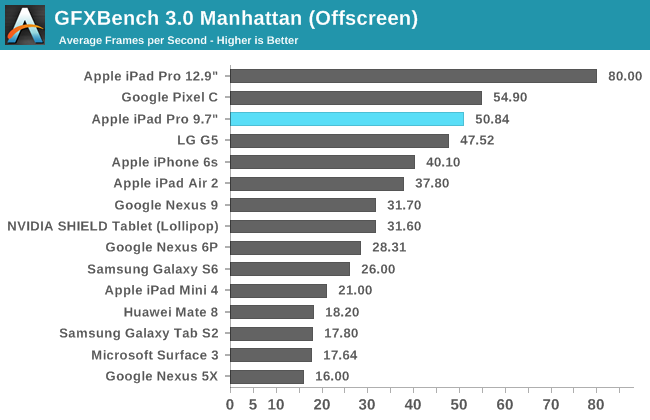
GFXBench 4.0 Car Chase hasn't made its way to iOS yet, and so for now we're still using GFXBench 3.0 Manhattan for iOS devices. Given that the iPhone 6s is the only phone that hits Vsync in this test, it's still a very relevant benchmark in how it represents the level of visual fidelity that a mobile game can currently have on high end devices while still performing well. In the off screen test we can see the impact of the 9.7" iPad Pro's lower clocked GPU combined with the reduced memory bandwidth,, with the smaller iPad performing around 37% lower than that of the 12.9" iPad Pro. The on screen test tells an interesting story though. Both models of the iPad Pro have roughly the same performance at their native resolutions in this test, which could indicate that Apple was targeting the same performance relative to the display resolution when configuring A9X and its memory, in order to manage heat and energy usage in a smaller iPad Pro.
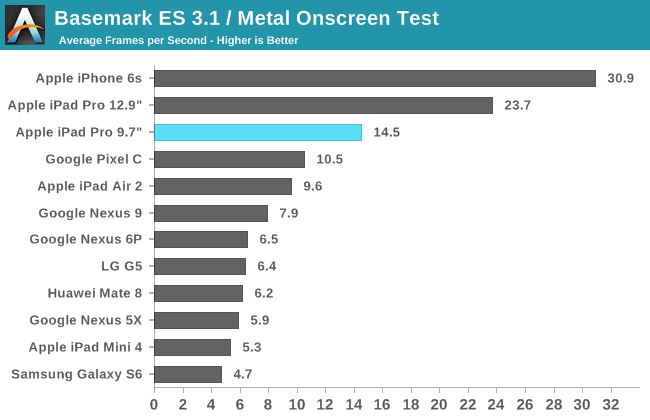
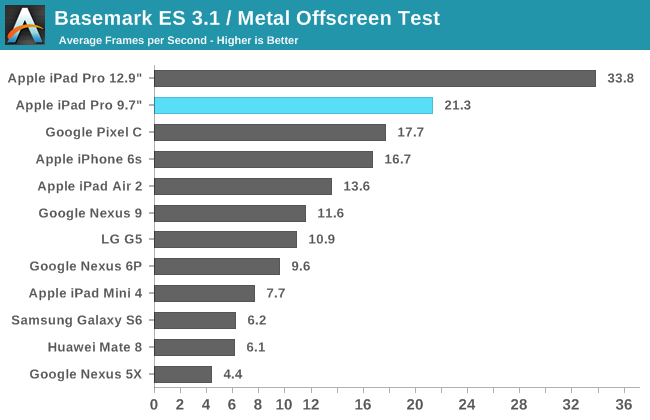
While I didn't have enough data to use BaseMark ES 3.1 at the time of my iPhone SE review, we've since tested enough older devices to deploy it. One could think of this as the successor to BaseMark X, which we retired some time ago before we officially deployed a new mobile test suite for 2016. Once again, both models of the iPad Pro sit above the other tablets on the chart. The iPhone 6s places first in the on screen test due to its relatively low resolution, but without that there the iPads would hold the top two spots in both tests.
NAND Performance
Something that Apple publicized with their A9 and A9X SoCs is improved NAND performance. NAND performance isn't discussed very much in reviews, but it's a very critical aspect of device performance and issues with it tend to cause a device's performance to crash months down the line rather than right off the bat, which makes it something of an invisible problem if you don't look for it during a review. We've seen previously that Apple has been using their own SSD controller in the current generation of iOS devices, and the 9.7" iPad Pro continues this.
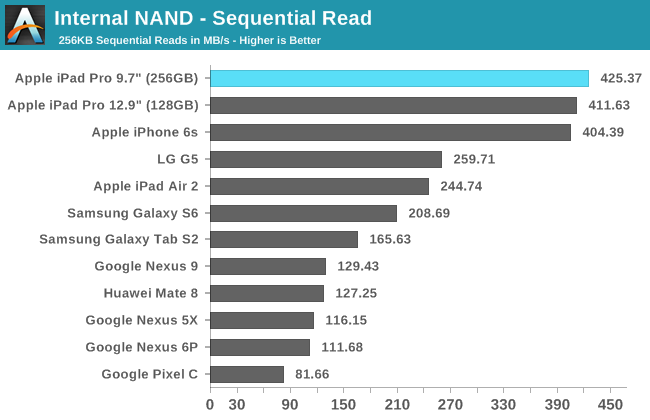
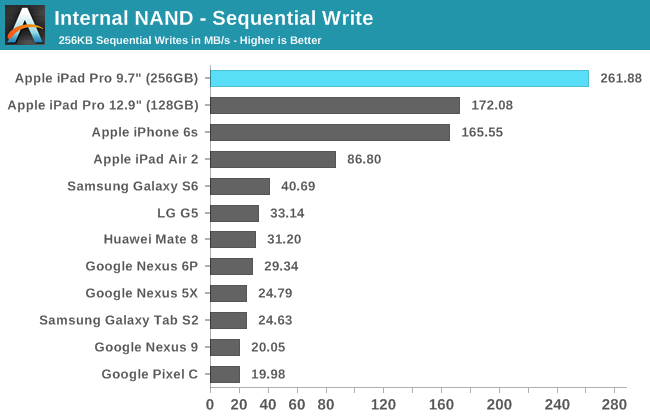
For this review I was sampled the 256GB model of the 9.7" iPad Pro. Because SSDs exploit parallelism heavily to improve performance, a 256GB iPad could improve NAND write performance over the lower-capacity models if it has a greater number of dies. In this case we see that sequential read performance improves a bit, while sequential writes improve dramatically as expected. There's not a lot to say here, as Apple has an enormous lead over the competition in this area.










144 Comments
View All Comments
name99 - Wednesday, June 1, 2016 - link
"The 9.7" iPad Pro does well in 3DMark's graphics test, but like Ice Storm it doesn't do well in the physics test. It seems that this test is programmed in a similar way to Ice Storm, and in that sense I'm not sure how representative the physics test is of real-world performance "The physics test conveys utterly no information. If you look at the code, it's obvious that the physics score basically scales as frequency*numberOfCores. So those octacore CPUs get their one (and only...) chance to shine.
But all you're learning is something you already knew --- that the SoC has lotsa cores running at a high frequency. You're learning nothing predictive about how those cores behave on real code.
An analogy is to judging an SSD by its interface speed --- "ooh, it supports PCIe3x4 --- obviously it must run at 4GB/s under any and all circumstances", or to assuming that the only number you need to know about a memory system is that it connects to DDR4@2400.
name99 - Wednesday, June 1, 2016 - link
I find the NAND performance numbers very interesting when compared to that tiny new Samsung BGA SSD:http://www.anandtech.com/show/10385/samsung-begins...
Sure the Samsung numbers are perhaps 3x higher (given different testing methodologies, etc) but I suspect the Samsung volume and power are SUBSTANTIALLY higher. So Apple is doing remarkably well. It would be interesting to know if they are using tricks like TurboWrite (ie use part of the flash as pseudo-SLC) or if that's still on the table, available for next year's performance boost.
sfwineguy - Thursday, June 2, 2016 - link
Very useful review. Because my own habits may differ from other users, I'm still unsure as to whether I should spring for this new one of try to find an Air 2 (hopefully one with 64 gigs rather than the 16 Apple is offering direct). It seems a bunch of the benefit from the Pro is the camera, which is something I just don't care about.If they had given this the 4 gigs of RAM in the larger Pro, it would be a no brainer for me. I feel like Apple always holds back on the RAM (and tells us we don't need it), which obsoletes their devices quicker than I would like.
ragingfighter - Wednesday, July 13, 2016 - link
In general apple holds back so they get you to upgrade it's a business model it's the way it has to work or you'll be keeping your iPad forever. IN my opinion, I think even if you had a first generation Erewhon is aware the tablet to hold onto. You really have to ask yourself this is it worth spending $600 more not counting the pencil for an additional hundred or the keyboard for an additional 150 that's if you're talking about their base model if you're going be on that then you have to ask yourself if it's worth spending closer to seven to $800. What do you use your tablet for now? Do you find it slow? Have you went to the store and did a side-by-side such a Staples Best Buy or Apple? I would recommend doing that use them a little bit or even go as far as biting the bullet and buy an iPad Pro from Bestbuy demo them side-by-side on the weekend and decide then whether you going to keep it or return it. Depending on where you're from your givien A window of I believe 14 days to return at least a Best Buy it might be an option for you to try them of them both, but your conclusion and stick with itRobertJasiek - Thursday, June 2, 2016 - link
DisplayMate measures "lowest reflectance" but this is the best only for glare displays. Tablets with semi-matte, capacitative touch display must have a much lower reflectance but, unfortunately, so far come with 16:9 or 16:10 display ratios.I wish a Windows tablet with matte, semi-matte or current iPad-like low reflectance display; iPad-like display ratio, casing, weight, battery duration; battery replaceability or service; great WLAN range; BGA SSD; USB and thunderbolt 3. Still the manufacturers of Windows tablets fails to offer displays suitable outdoors with an acceptably low display ratio and a casing suitable for hours of hand holding.
Many iOS apps do not help if the needed functionality is not available; I find it only for Windows or maybe Linux. This and the missing general file management under iOS mean that 2/3 of my tasks incl. productivity (other than simple proofreading) is impossible on iPads. Therefore the iPad Pro 9.7 is too expensive. Its good hardware can never compensate the failure of iOS and apps. This may be different for some needing only mainstream apps and file formats.
adamod - Thursday, June 2, 2016 - link
i would buy it but its waaaay to thick for me...totally unacceptablearsjum - Thursday, June 2, 2016 - link
Is this sarcasm?samer1970 - Thursday, June 2, 2016 - link
the best tablet ? I dont think so , Core M3/5/7 Tablets are better and with full windows 10Hemlocke - Thursday, June 2, 2016 - link
Have you actually used them as tablets? The SP4 is a terrible tablet. It's heavier, it's stuck in landscape, it lacks a lot of touch-optimized apps, it has an inferior screen, and it has inferior battery life.Oh, but Windows, you say. That's great. To get a decent Windows experience laptop out of it, you're spending $1200 for everything, and a $999 Razer Blade Stealth smokes the half-assed laptop that is the SP4, leaving you with $200 to buy an Nvidia Shield Tablet K1, which is still a better tablet experience than the SP4.
nikon133 - Friday, June 3, 2016 - link
Have you used Surface as a tablet, though?I'm using SP3 as my main tablet and laptop. It is stuck in landscape only if you want to use kickstand. If you want to hold it in your hands, it works in portrait just fine. Since I love kickstand, only scenario I use it in portrait is for comics, which I read in app called Cover. Everything else I do in landscape, and even with heavier hardware, being able to use tablet with one hand (while it sits on my lap or on bed, table... at angle I like) while having the other hand free to hold a cup, glass, sandwich... is more than worth extra weight.
I have all the apps I need for tablet mode. Granted I'm not too demanding with apps, but usual stuff - browser, mail client, FB, maps, weather, FB messenger and Skype, YouTube player, News client, comics and ebook readers, music and media players... are all there and perform well under touch.
I can get 8 hours of light usage out of fully charged Surface Pro 3. Most common scenario, browsing, will fluctuate wildly, but hit usually comes with Flash-heavy sites. Not sure if I can open them on iPad at all. And then, there's very nice type cover sitting in vicinity - if at any moment I decide that whatever casual I do will require some serious typing, transformation is 1 second away.
As a laptop - surprisingly enough, SP4 released keyboard (which works with SP3, too) is one of finest laptop keyboards I have ever used, and even touchpad is quite good - maybe not on MB level, but as good as any Windows laptops does... and I still get to use touch screen, which I do. I wouldn't like touch screen on my desktop's screen, but on small screen that usually sits closer to me than desktop, it makes a lot of sense.
My SP3 also has full Office, Photoshop, Lightroom... among few other desktop programs. I'm using desktop for really heavy lifting at home - and gaming - and SP3 replaces laptop and tablet very nicely for me, at home and on travels. iPads are nice - I'm buying them for my mother every 2 years or so - but they just can't replace both laptop and tablet for me, and since I live in NZ - almost every trip is intercontinental, and having one device less to drag is easily noticeable.